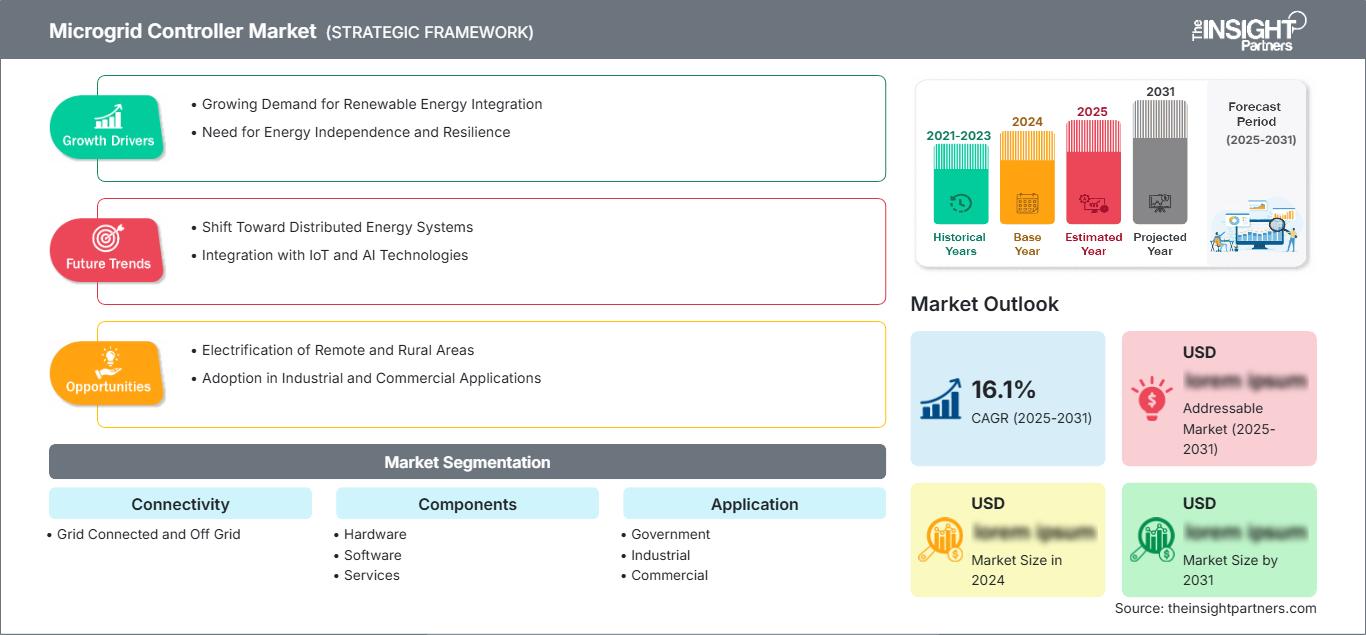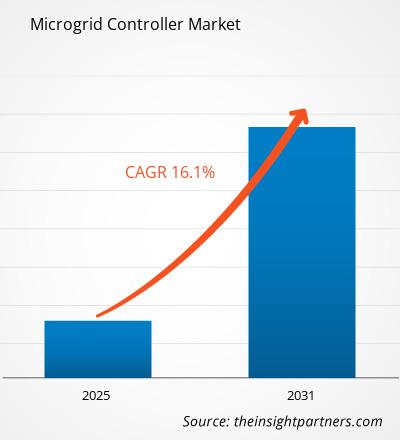The Microgrid Controller Market is expected to register a CAGR of 16.1% from 2025 to 2031, with a market size expanding from US$ XX million in 2024 to US$ XX Million by 2031.
The report is segmented by Connectivity (Grid Connected and Off Grid), Components (Hardware, Software, and Services), Application (Government, Industrial, Commercial, Healthcare, Military and Defense, Educational Institutes, and Others). The global analysis is further broken-down at regional level and major countries. The report offers the value in USD for the above analysis and segments
Purpose of the Report
The report Microgrid Controller Market by The Insight Partners aims to describe the present landscape and future growth, top driving factors, challenges, and opportunities. This will provide insights to various business stakeholders, such as:
- Technology Providers/Manufacturers: To understand the evolving market dynamics and know the potential growth opportunities, enabling them to make informed strategic decisions.
- Investors: To conduct a comprehensive trend analysis regarding the market growth rate, market financial projections, and opportunities that exist across the value chain.
- Regulatory bodies: To regulate policies and police activities in the market with the aim of minimizing abuse, preserving investor trust and confidence, and upholding the integrity and stability of the market.
Microgrid Controller Market Segmentation
Connectivity
- Grid Connected and Off Grid
Components
- Hardware
- Software
- Services
Application
- Government
- Industrial
- Commercial
- Healthcare
- Military and Defense
- Educational Institutes
- Others
Geography
- North America
- Europe
- Asia-Pacific
- South and Central America
- Middle East and Africa
You will get customization on any report - free of charge - including parts of this report, or country-level analysis, Excel Data pack, as well as avail great offers and discounts for start-ups & universities
Microgrid Controller Market: Strategic Insights

-
Get Top Key Market Trends of this report.This FREE sample will include data analysis, ranging from market trends to estimates and forecasts.
Microgrid Controller Market Growth Drivers
- Growing Demand for Renewable Energy Integration: The increasing reliance on renewable energy sources, such as solar and wind, is a key driver for the microgrid controller market. Microgrid controllers enable seamless integration of renewable energy into local grids by managing energy generation, storage, and distribution. As the global shift toward renewable energy accelerates, the need for efficient, autonomous energy management systems like microgrid controllers becomes critical to ensure grid stability and reliability.
- Need for Energy Independence and Resilience: The growing need for energy independence and resilience, especially in remote areas or regions with unreliable power grids, is driving the adoption of microgrids. These systems allow localized generation and storage of energy, reducing reliance on the main grid. Microgrid controllers enable real-time optimization and control, ensuring that local grids can operate efficiently during grid outages or emergencies.
Microgrid Controller Market Future Trends
- Shift Toward Distributed Energy Systems: A significant trend in the energy sector is the shift toward decentralized or distributed energy systems. Microgrids, supported by advanced controllers, are at the forefront of this movement, enabling local energy generation, consumption, and storage. This decentralization allows for more resilient, efficient, and sustainable energy solutions, driving the demand for microgrid controllers across residential, industrial, and commercial applications.
- Integration with IoT and AI Technologies: The integration of IoT (Internet of Things) and AI (artificial intelligence) technologies into microgrid controllers is gaining traction. These technologies enable advanced features like predictive maintenance, real-time data analytics, and adaptive energy management, which enhance microgrid performance and reliability. As these technologies continue to evolve, they will play a crucial role in optimizing energy usage and improving the efficiency of microgrids.
Microgrid Controller Market Opportunities
- Electrification of Remote and Rural Areas: Microgrid controllers present a major opportunity for electrification in remote and rural areas that are off the main grid. These areas can benefit from localized energy generation and storage systems, reducing dependency on traditional energy infrastructure. As governments and organizations focus on improving energy access in underserved regions, the demand for microgrid controllers is expected to rise.
- Adoption in Industrial and Commercial Applications: Industries and commercial establishments are increasingly adopting microgrid systems to improve energy efficiency, reduce costs, and enhance energy security. Microgrid controllers play a critical role in optimizing energy flows, enabling these sectors to harness renewable energy sources while ensuring a stable power supply. This growing trend offers significant market opportunities in industrial and commercial applications for microgrid controllers.
Microgrid Controller Market Regional Insights
The regional trends and factors influencing the Microgrid Controller Market throughout the forecast period have been thoroughly explained by the analysts at The Insight Partners. This section also discusses Microgrid Controller Market segments and geography across North America, Europe, Asia Pacific, Middle East and Africa, and South and Central America.
Microgrid Controller Market Report Scope
| Report Attribute | Details |
|---|---|
| Market size in 2024 | US$ XX million |
| Market Size by 2031 | US$ XX Million |
| Global CAGR (2025 - 2031) | 16.1% |
| Historical Data | 2021-2023 |
| Forecast period | 2025-2031 |
| Segments Covered |
By Connectivity
|
| Regions and Countries Covered |
North America
|
| Market leaders and key company profiles |
|
Microgrid Controller Market Players Density: Understanding Its Impact on Business Dynamics
The Microgrid Controller Market is growing rapidly, driven by increasing end-user demand due to factors such as evolving consumer preferences, technological advancements, and greater awareness of the product's benefits. As demand rises, businesses are expanding their offerings, innovating to meet consumer needs, and capitalizing on emerging trends, which further fuels market growth.

- Get the Microgrid Controller Market top key players overview
Key Selling Points
- Comprehensive Coverage: The report comprehensively covers the analysis of products, services, types, and end users of the Microgrid Controller Market, providing a holistic landscape.
- Expert Analysis: The report is compiled based on the in-depth understanding of industry experts and analysts.
- Up-to-date Information: The report assures business relevance due to its coverage of recent information and data trends.
- Customization Options: This report can be customized to cater to specific client requirements and suit the business strategies aptly.
The research report on the Microgrid Controller Market can, therefore, help spearhead the trail of decoding and understanding the industry scenario and growth prospects. Although there can be a few valid concerns, the overall benefits of this report tend to outweigh the disadvantages.
Frequently Asked Questions
What are the options available for the customization of this report?
What are the deliverable formats of the market report?
What are the future trends of the microgrid controller market?
What are the driving factors impacting the global microgrid controller market?
What is the expected CAGR of the microgrid controller market
- Historical Analysis (2 Years), Base Year, Forecast (7 Years) with CAGR
- PEST and SWOT Analysis
- Market Size Value / Volume - Global, Regional, Country
- Industry and Competitive Landscape
- Excel Dataset
Recent Reports
Testimonials
Reason to Buy
- Informed Decision-Making
- Understanding Market Dynamics
- Competitive Analysis
- Identifying Emerging Markets
- Customer Insights
- Market Forecasts
- Risk Mitigation
- Boosting Operational Efficiency
- Strategic Planning
- Investment Justification
- Tracking Industry Innovations
- Aligning with Regulatory Trends





















 Get Free Sample For
Get Free Sample For